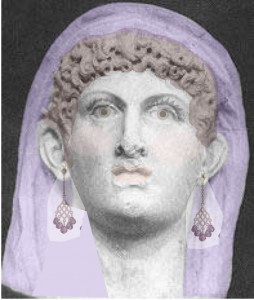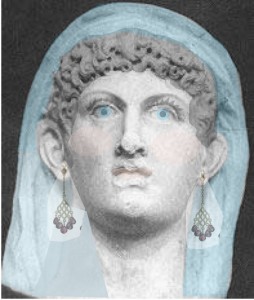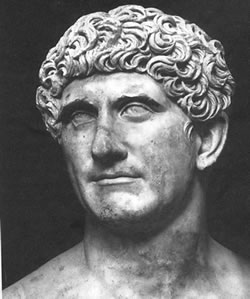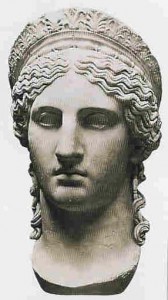I’m pretty sure I’ve never done anything that was such a waste of time before–especially considering my lack of artistic skill and tools, but one of the things that always creeps me out about Roman statuary is the dead eyes. On the one hand, I prefer the marble aesthetic. It’s beautiful. But the Romans painted their statues–probably because of the creepy eyes. They also dressed them and put jewelry on them.
Today, I indulged in a similar exercise by both trying to add in pieces of this statue of Cleopatra Selene that have been chipped away, and giving some semblance of life. She looks quite a bit like her father. Unfortunately, I can’t get the lips or nose right because they have been broken off the face of the statue.

Bust of Cleopatra Selene Colorized
What’s most interesting to me is the masculine style of her hair. The women in the imperial family like Livia and Octavia famously sported feminine hairstyles, usually parted melon style or raised up in the front like a uraeus.
By contrast, in this statue, Selene has adopted the hairstyle of an imperial man. Much like the hairstyle sported by her own father in his famous bust.
You also see similar hairstyles on Augustus, Juba, Gaius…all rulers or rulers-to-be. Coincidence? I think not.
For more contrast, this is a bust of Cleopatra Selene’s half-sister, Antonia Minor, also a daughter of Mark Antony (Marcus Antonius):
Updated: Irene Hahn pointed out to me that this hairstyle is also very Greek in appearance. Certainly, Selene considered herself to be a Hellenized queen, so there may not have ever been any danger of her styling her hair like Livia or Octavia.





Nice eye for detail.
I think that she looks a lot like what her mother would have looked like. With slightly more delicate features.
Great post and observation about the hairstyle and it’s connection to her father’s (and by implication, imperial authority). Very Cool!
Thanks Vicky! Also, I’m one chapter into CLEOPATRA’S MOON and it’s just beautifully done.
She does seem to be spared her father’s nose, thank goodness.
Maybe only due to my reconstruction. I tried to fill in the chipped off nose with white. Failing that, I thought about stealing Antonia’s nose and mouth and grafting it onto the photo. It looks like SHE got her father’s nose, but she presents a more feminine portrait.
I’ve always thought the idea of having them painted was even more creepy than the white marble. I wish we could see the way they had been though.
Isn’t it strange how used to the unpainted version we’ve become? It’s almost as if a future generation would have found only our black and white movies, and been kind of freaked out to know that we had colors!
Their opinion of us might be better if they could only find our old black and white movies and not what movies eventually became. 🙂
You have a point, Lindsey!
I always thought it was more like the father than the mother! It’s so sad we don’t have more statues of her or her family…
I think if we could do more archeological work in Algeria we might find some more!
for my taste, I’ll go with the all white creepy eye version. The colorized version reminds me on one of my friends! yikes.
I hate to ask which one 😛